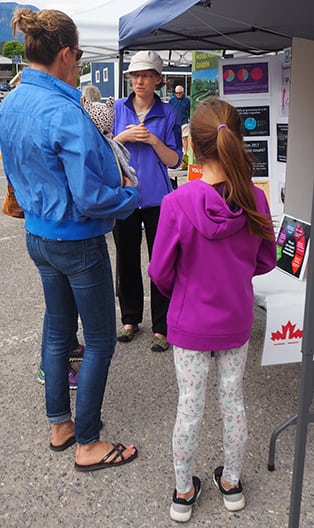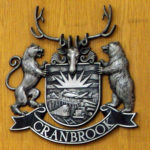Home »

A closer look at First-Past-the-Post
Part II in a series on BC Electoral Reform
By Carol Gordon
 Amber Van Drielen is a lawyer who lives in Golden, British Columbia. She describes herself as an “electoral reform advocate and engaged citizen” and became a supporter of Proportional Representation more than a decade ago. These are excerpts from a recent interview I conducted with her (see Part I – Putting A Face on Electoral Reform).
Amber Van Drielen is a lawyer who lives in Golden, British Columbia. She describes herself as an “electoral reform advocate and engaged citizen” and became a supporter of Proportional Representation more than a decade ago. These are excerpts from a recent interview I conducted with her (see Part I – Putting A Face on Electoral Reform).
Q What do you think is working with regards to British Columbia’s First Past the Post (FPTP) Electoral System?
That’s a difficult question for me to answer. I know that some will point out that our First-Past-the-Post (FPTP) Electoral System works because we give power to one political party and then as a government they make all the decisions without having to consult or negotiate with any other political parties/viewpoints. You will hear this called “stable government.”
I have the expectation that a “stable” government is elected with more than 50% support from voters. Our provincial and federal “so called majority” governments very rarely have more than 50% voter support.
Q Speak more about what you see is the problem with this situation.
As we know, with the FPTP electoral system, candidates representing the different political parties run against each other for a single seat (in the provincial Legislature or federal Parliament). The candidate who earns the most votes wins the riding (electoral district). All that is needed to win is one vote more than the next candidate.
 As we’ve seen in (many recent) past elections, the candidate with the most votes usually receives significantly less than 50% of the votes. Because the governing party does not have the support of the majority of the voters, that means that we consistently have “false majority” governments.
As we’ve seen in (many recent) past elections, the candidate with the most votes usually receives significantly less than 50% of the votes. Because the governing party does not have the support of the majority of the voters, that means that we consistently have “false majority” governments.
With the FPTP electoral system, there is no relationship between the percentage of votes cast for a particular (political) party and the number of seats (and the power) that the party has in the legislature. Given the significant economic, social and environmental decisions being made in our legislature and the real impact they have on our daily lives, this is not a trite issue.
In British Columbia, since 1956, 88% of so-called “majority” governments have been “false” majorities. The party won the election but didn’t receive a majority of votes. This is the norm with the FPTP voting system when multiple parties run against each other for a single seat.
Other recent examples of this (false majorities) include the Stephen Harper Conservative Federal Government of 2011, the Justin Trudeau Liberal Federal Government of 2015, the Rachel Notley New Democratic Alberta Government of 2015 as well as the Doug Ford Conservative Ontario Government of 2018.
In all these cases, their (winning) parties received 39 to 41% of the votes but ended up with a majority of the seats in the Parliament or Legislature, and it resulted in their party having complete control. The minority ends up ruling the majority.
Q It seems that we have become accustomed to this political scenario. What are the challenges you see with it?
When we have a false majority government, in which the government does not represent a majority of voters, the government feels no need to reach out to (the other political parties) and try to work together with them to find common ground.
There is an intense polarization between political parties resulting in divisiveness and conflict and is particularly evident in the negative campaigning during each election cycle.
The FPTP electoral system does not reward (the seeking of) common ground. While in most other aspects of our life, we communicate, negotiate and compromise. Not so with our politicians elected under FPTP electoral system. Once elected with a false majority the norm is for the government to proceed unilaterally while the combined opposition political parties, which represent the majority of voters, yell and complain from the sidelines in their powerless position.

Even large political parties with substantial political support may sit on the sidelines for years, without input into government decision-making. To win the next election, once a political party is in government, the decision making tends to be very short sighted and is focused on policies that are seen to be reasonable and achievable within the election cycle. This is a feature somewhat unique to the FPTP electoral system. Other voting systems reward long term planning, consistency in policy, and cooperation between political parties.
With FPTP we also get significant policy lurch as one government is thrown out and the next comes in and reverses direction. What I see is a constant fight and flip flop back and forth between government extremes with little consistency in policy as each is able to govern unilaterally. Each time the government changes party, there are huge policy swings resulting in policy instability in such areas as taxes and environment.
Q What are your thoughts on strategic voting?
Strategic voting is unique to the FPTP voting systems. In every election, rather than voting for the policies they like, large numbers of people vote “strategically” to try and avoid electing their least favourite candidate. I read that in their recent provincial election, 40% of voters in Ontario strategically voted. This is not atypical of how our elections unfold, particularly if there is a politician who some consider to be divisive.
Rather than voting for what they want, people are voting against what they don’t want. So we don’t know (from election results) what values and priorities people really have.
Q Do you think it is possible to make decisions with a lot of voices or do you think it complicates it?
I think it is quite possible. Countries around the world are doing it all the time. You do need to do more listening and communicating which results in better understanding the issues that people are facing. There are a lot of good ideas to tap into.
Most of us do not see the world through the lens of a political party. Political parties are a convenient way of organizing clusters of political and policy ideas to help voters identify their preferences. I would argue that most of us could find policies that we find okay, interesting or least worth exploring in just about every political party.
When you have to listen to what other political parties’ positions are and what other people’s needs are, and you have to work together to cooperate, collaborate, communicate and listen, you are more likely to end up serving a broader set of needs, because you’ve heard from all these different people. It may not be that different from a policy that is implemented, but it is going to include the needs of more people. Ultimately, if you’re thinking about representative democracy, it’s supposed to represent the people, not just a small subset of interests.
To me, representative democracy means representing the people and developing relevant policies for the people where they live, on an array of issues from earning a living, to housing to education. In order to do this you have to actually know what the issues are and hear them being raised and discussed at the (government’s) decision making table. If they aren’t being heard at the (government’s) decision making table, they’ve either been forgotten, ignored or are not known.
There has only been one true majority government in B.C. since 1956. This was the 2001 government elected by 57% of the voters. It is great that a party was able to put together a platform and policies that actually appealed to a true majority of voters. However, due to our FPTP voting system, this 57% support by voters magically turned into 97% of the seats in the legislature! In other words, 43% of the voters, those who did not vote for the governing party, received only two seats for their efforts in making it to the polling station and casting a vote.
Q Amber, do you think electoral reform is important for our democracy?
First of all, I come from the perspective that democracy is important. If we don’t care about democracy, then we may not care about electoral reform. Democracy is not perfect, but it is better than many other systems in existence around the world. We need to protect our democracy and evaluate, periodically, whether improvements can be made.
Democracy (to me) means “people power” and is a safeguard against one small interest group making decisions for us all. I see democracy as an open and inclusive process whereby decisions are made by the majority while still respecting minority rights. Democracy includes having a diversity of voices at the decision making table.
Updating our voting system will not address all democratic deficits, but it will be a solid step in the right direction. It will allow for more fairness, more accountability, more representation and more effective governance.
To learn more about the upcoming October 22 – November 30, BC Electoral Reform Referendum: Read the report (PDF); Electoral reform referendum questions released.








